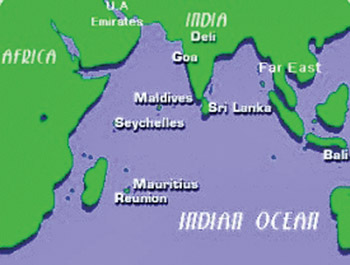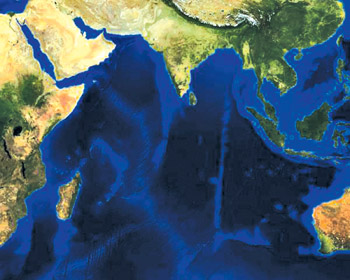|

Sea levels rising in parts of Indian
Ocean
Greenhouse gases play role, study reveals:
Newly detected rising sea levels in parts of the Indian Ocean,
including the coastlines of the Bay of Bengal, the Arabian Sea, Sri
Lanka, Sumatra and Java, appear to be at least partly a result of
human-induced increases of atmospheric greenhouse gases, says a study
led by the University of Colorado at Boulder.

The study, which combined sea surface measurements going back to the
1960s and satellite observations, indicates anthropogenic climate
warming likely in amplifying regional sea rise changes in parts of the
Indian Ocean, threatening inhabitants of some coastal areas and islands,
said CU-Boulder Associate Professor Weiqing Han, lead study author. The
sea level rise which may aggravate monsoon flooding in Bangladesh and
Indiacould have far-reaching impacts on both future regional and global
climate.
The key player in the process is the Indo-Pacific warm pool, an
enormous,bathtub-shaped area of the tropical oceans stretching from the
east coast of Africa west to the International Date Line in the Pacific.
The warm pool has heated by about 1 degree Fahrenheit, or 0.5 degrees
Celsius, in the past 50 years, primarily caused by human-generated
increases of greenhouse gases, said Han.
"Our results from this study imply that if future anthropogenic
warming effects in the Indo-Pacific warm pool dominate natural
variability, mid-ocean islands such as the Mascarenhas Archipelago,
coasts of Indonesia, Sumatra and the north Indian Ocean may experience
significantly more sea level rise than the global average," said Han of
CU-Boulder's atmospheric and oceanic sciences department.
A paper on the subject was published in Nature Geoscience.
While a number of areas in the Indian Ocean region are showing sea
level rise, the study also indicated the Seychelles Islands and Zanzibar
off Tanzania's coastline show the largest sea level drop. Global sea
level patterns are not
geographically uniform, and sea rise in some areas correlate with sea
level fall in other areas, said NCAR's Meehl.
The Indian Ocean is the world's third largest ocean and makes up
about 20 per cent of the water on Earth's surface.The patterns of sea
level change are driven by the combined enhancement of two primary
atmospheric wind patterns known as the Hadley circulation and the Walker
circulation. The Hadley circulation in the Indian Ocean is dominated by
air currents rising above strongly heated tropical waters near the
equator and flowing poleward, then sinking to the ocean in the
|

The mapped image of the Indian Ocean |
subtropics and causing surface air to flow back toward the equator.
The Indian Ocean's Walker circulation causes air to rise and flow
westward at upper levels, sink to the surface and then flow eastward
back toward the Indo-Pacific warm pool. "The combined enhancement of the
Hadley and Walker circulation form a distinct surface wind pattern that
drives specific sea level patterns," said Han.
The international research team used several different sophisticated
ocean and climate models for the study."Our new results show that
human-caused changes of atmospheric and oceanic circulation over the
Indian Ocean region -- which have not been studied previously are the
major cause for the regional variability of sea level change," wrote the
authors in Nature Geoscience.
Han said that based on all-season data records, there is no
significant sea level rise around the Maldives. But when the team looked
at winter season data only, the Maldives show significant sea level
rise, a cause for concern. .
The new study indicates that in order to document sea level change on
a global scale, researchers also need to know the specifics of regional
sea level changes that will be important for coastal and island regions,
said NCAR's Hu. Along the coasts of the northern Indian Ocean, seas have
risen by an average of about 0.5 inches, or 13 millimeters, per decade.
"It is important for us to understand the regional changes of the sea
level, which will have effects on coastal and island regions," said Hu.
-ScienceDaily
Pen-pals
Name: Chanaka Chathuranga
Gender: Male
Age: 16
Hobbies: Cycling, playing
football, listening to music, watching movies
Pen-pals preferred from:
Sri Lanka, Japan, Australia
Age group: 14-16
Address: "Wijaya"
Illukgollawatta, Keppetipola, Sri Lanka.
*****
Name: Rasanjana Dilan
Gender: Male
Age: 14
School: St. John's
College, Nugegoda
Hobbies: Playing computer
games, watching T.V., reading books, writing letters to friends.
Pen-pals preferred from:
UK, Russia, China, Sri Lanka.
Age group: 10-14
Address: 17/4, Lumbini
Stores, Madapatha, Piliyandala, Sri Lanka.
*****
Name: A.L. Dwpadee
Sawbagya
Gender: Female
Age: 10
School: R/Ayagama Sri
Rahula Central College
Hobbies: Collecting
stamps, reading books, playing computer games
Pen-pals preferred from:
Any country
Age group: 8-11
Address: Sena Tailors,
Gawaragiri Road, Ayagama, Ratnapura, Sri Lanka.
*****
Name: A.L. Tharindu
Rukshan
Gender: Male
Age: 13
School: Sivali Central
College, Hidellana
Hobbies: Reading books,
playing computer games, collecting stamps, playing cricket.
Pen-pals preferred from:
Any country
Age group: 11-13
Address: Sena Tailors,
Gawaragiri Road, Ayagama, Ratnapura, Sri Lanka.
*****
Name: M.P. Achini Chandra
Kumari
Gender: Female
Age: 16
Hobbies:Collecting stamps,
reading story books
Pen-pals preferred from:
Sri Lanka, India, Australia, America
Age group: 14-16
Address: No.105, Suhada
Janapadaya Road, Palliyawatha, Alabodagama, Pannala, Sri Lanka. |

